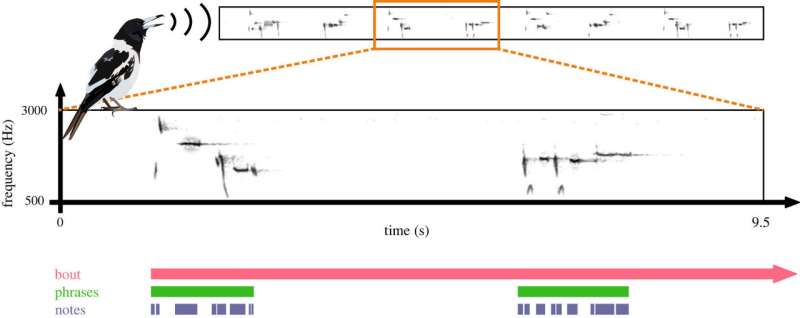Pied butcherbird nocturnal formal song hierarchy. A song bout may span several hours. During a bout, short bursts of singing followed by periods of silence are characterized as phrases, and the individual spectro-temporal events that populate each phrase are characterized as notes. Credit: Royal Society Open Science (2022). DOI: 10.1098/rsos.220704
An international collaboration between musicians and birdsong scientists has found that in the Australian pied butcherbird songs surveyed, the order of song elements is strongly related to rhythmical timing.
In a study published today on Australian pied butcherbirds in Royal Society Open Science, researchers found that the order of their song elements is strongly associated with the butcherbird's rhythmical timing.
In the human brain, grammatical syntax and musical rhythm processing have been found to share cognitive resources in the human brain, and this research shows that songbirds could be processing syntactic-rhythmic relationships in a similar manner to humans.
Dr. Hollis Taylor, ARC Fellow at the Sydney Conservatorium of Music, undertook this research along with colleagues from the University of California, San Diego.
They found that the order of song elements in Australian pied butcherbird songs share a predictive relationship with how the song elements are rhythmically timed, and that this relationship is retained when the length of song elements is controlled.
This suggests that the way syntax and rhythm interact with each other in pied butcherbird songs is not an artifact of simply producing song elements of different lengths in sequence.
"It is extremely exciting," observes Dr. Taylor. She has studied pied butcherbird vocalizations in Australia since 2005. From her base in Alice Springs, she records their long nocturnal songs each spring.
"This collaboration adds to my previous documentation of the myriad overlaps between pied butcherbird vocalizations and human music genres."
"Each bird sings differently, and phrases change annually. The songs are combinatorial, like snap-together beads. These birds are minimalist composers who have been on the planet some thirteen million years."
"Previously, songbird research has been dominated by studies of song syntax, or how song elements are ordered. Song rhythm, on the other hand, is relatively understudied. We know that if you provide a regular musical beat to children with communication disorders, their grammatical skills improve. To our knowledge, rarely anyone has thought about how syntax and rhythm might be related in birdsong."
"Instead, birdsong scholars have primarily studied song syntax via information theory, a theory originating in mathematics that is more concerned with the encoding of discrete symbols than temporally-continuous bio-acoustic signals. This has led to a rich and useful research literature on birdsong syntax, but other aspects of songbird behavior have been neglected."
"Information theory tends to treat birdsong as chunkable units; our paper shows we can more directly use music theory to patch some of the inherent problems of information theory."
Although behavioral laboratory research is needed to further understand if songbirds truly process syntactic-rhythmic relationships similarly to humans, researchers are moving closer to an understanding that songbird and human cognition may have more similarities than previously known, even though birds lack a layered cerebral neocortex that is thought to support complex cognition in humans.
This research affirms that music theory can help inform birdsong science. Music theory (and musicality research in general) have influenced several recent birdsong papers on song rhythm. As fellow researcher from the University of California Mr. Jeffrey Xing observes:
"Our paper adds to a gradually growing belief in the birdsong scientific community that we can start integrating what we know about how humans process music to understand how songbirds process their songs. In this pursuit, we can begin to understand the latent musicality of other animals, and in turn, re-examine our own musicality."
By showing how rhythmic analyses rooted in music theory interact with traditional syntactic analyses in birdsong sciences, the researchers demonstrate the robust potential of collaborations between music scholars and birdsong scientists.
More information: Jeffrey Xing et al, Syntactic modulation of rhythm in Australian pied butcherbird song, Royal Society Open Science (2022). DOI: 10.1098/rsos.220704
Journal information: Royal Society Open Science
Provided by University of Sydney
























